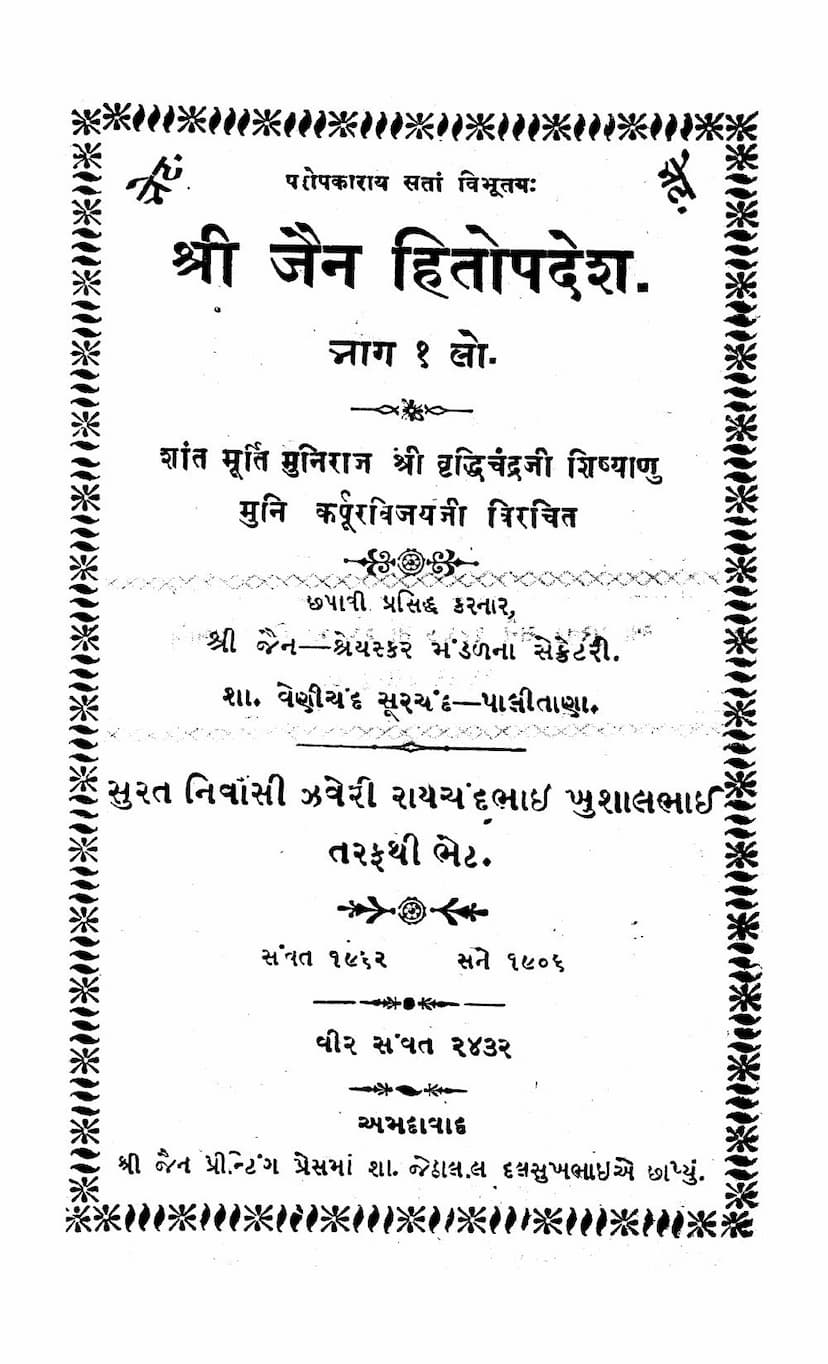Jain Hitopadesh
Added to library: September 2, 2025

Summary
This Jain text, "Jain Hitopadesh" by Karpurvijay, published by Jain Shreyaskar Mandal, is a comprehensive guide to Jain principles and practices. The book aims to awaken and ignite the curiosity of young Jain individuals about their faith.
The Table of Contents reveals the extensive coverage of various topics:
- Jain Child Guidance (185 types): Likely covers moral and ethical teachings for children.
- Essence of Precepts (concerning animal welfare, etc.): Focuses on core Jain values like compassion and non-violence.
- Praise of the Treasury of Proverbs: A collection of wise sayings.
- Essence of the Omniscient's Teachings (67 different topics): Detailed explanations of various Jain doctrines.
- Six Essential Practices (Samayika, etc.): Explains the purpose and significance of daily Jain rituals.
- Jain Festival Dates: Information about important Jain holidays.
- Renunciation of Night Meals: Discusses the practice of abstaining from eating at night.
- Not Counting What Has Been Read: Emphasizes the importance of understanding and application over mere reading.
- Navkar Mahamantra: A detailed exposition of the most sacred Jain mantra.
- Adoption of Excellent Qualities: Guidance on cultivating virtuous traits.
- Fifty-two Festivals for Each Tirthankara: Information about the lives and teachings of the Tirthankaras.
- Collection of Various Subjects: A miscellany of important Jain teachings.
- 35 Qualities of a Follower of the Path: Outlines the characteristics of a devout Jain.
- Garland of Excellent Proverbs: Another collection of wise sayings.
- Sajhayan of the Eighteen Places of Sin: Discusses actions that lead to negative karmic consequences.
The Preface highlights the core Jain philosophy: achieving liberation (moksha) through right knowledge (samyak gyan), right perception (samyak darshan), and right conduct (samyak charitra). It stresses that right perception is impossible without right knowledge, which comes from understanding the true nature of the nine substances (nav tattva), the six realities (shat dravya), and the principles of pure deities, gurus, and dharma. Samyak darshan (correct belief) is described as a wish-fulfilling jewel, requiring great effort to attain and even greater effort to preserve. Right conduct is essential to make right knowledge and perception meaningful. The ultimate goal is the complete cessation of birth, aging, and death, and the attainment of infinite, unchanging bliss – the ultimate liberation. The author expresses hope that this book will serve as a catalyst for awakening and contribute to the progress of the holy Jain tradition.
The book then proceeds to detail various aspects of Jainism through a question-and-answer format and descriptive chapters:
- Chapter 1: Jain Child Guidance (Prashnottar): This chapter defines what it means to be a Jain, the meaning of "Jina" (conqueror of passions), the qualities of Arhats, and synonyms for Jin. It also explains the roles of a Jain guru and the meaning of various terms like Sadhu, Nirgranth, Mumukshu, etc. It elaborates on the five great vows (Mahavratas) for monks and the vows for householders (Anuvratas), including the principles of non-violence, truthfulness, non-stealing, celibacy, and non-possession, as well as the supplementary vows (Gunavratas) and training vows (Shikshavratas).
- Chapter 2: Essence of Precepts: This section offers concise advice on various virtues and ethical conduct, such as the importance of compassion, truthfulness, avoiding theft, celibacy, controlling greed, anger, pride, deceit, attachment, hatred, criticism, slander, and the importance of serving pure deities, gurus, and dharma.
- Chapter 3: Treasury of Proverbs (Prashna-Uttar Ratnamala): A dialogue between a disciple and a guru, covering essential spiritual and philosophical concepts in a concise and insightful manner.
- Chapter 4: Essence of the Omniscient's Teachings: Presents 68 concise teachings with brief explanations, covering various aspects of Jain philosophy and practice.
- Chapter 5: Six Essential Practices: Details the six fundamental daily rituals (Samayika, etc.) and their underlying purposes. It also explains the significance of Jain festivals.
- Chapter 6: Jain Festival Dates: A list of important Jain festival dates.
- Chapter 7: Renunciation of Night Meals: Discusses the importance and benefits of refraining from eating at night.
- Chapter 8: Not Counting What Has Been Read: Emphasizes the need for practical application of knowledge.
- Chapter 9: Navkar Mahamantra: Explains the significance and power of the Navkar mantra.
- Chapter 10: Adoption of Excellent Qualities: Guides on cultivating virtues by reflecting on the lives and examples of the Tirthankaras and other enlightened beings.
- Chapter 11: Collection of Various Subjects: Includes information on the six realities (shat dravya), four modes of speech (char naya), eight karmic obstructions (ashta karma), nine realities (nav tattva), four means of knowledge (char praman), the difficulty of human birth, the four refuges (char sharan), eight auspicious symbols (ashta mangal), and other relevant details.
- Chapter 12: 35 Qualities of a Follower of the Path: This chapter elaborates on the virtues and practices expected of a devout Jain, covering principles of justice in business, etiquette, religious conduct, avoiding sin, respecting elders, the importance of good company, fulfilling vows, and practicing compassion and equanimity.
The book also includes a section on the Fifty-two Festivals for Each Tirthankara, detailing their names, parents, birth cities, birth dates, and other biographical information. This is followed by a discussion on the Importance of Vows for both monks and householders, and the various types of food and practices to be avoided, such as night meals and consuming roots.
The text aims to provide a comprehensive understanding of Jainism, encouraging its readers to live a life guided by its ethical principles and spiritual practices, ultimately leading to liberation.